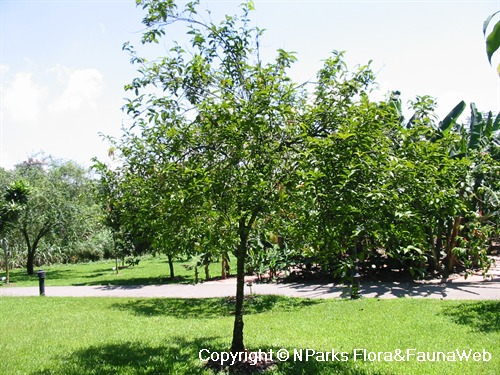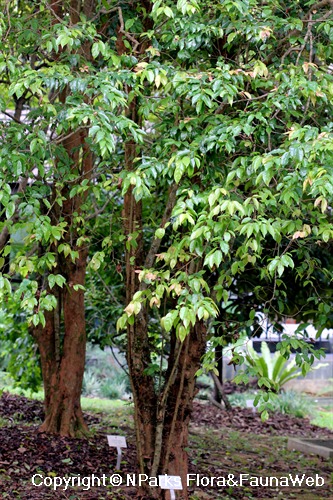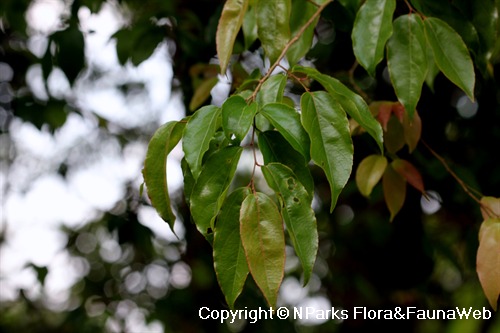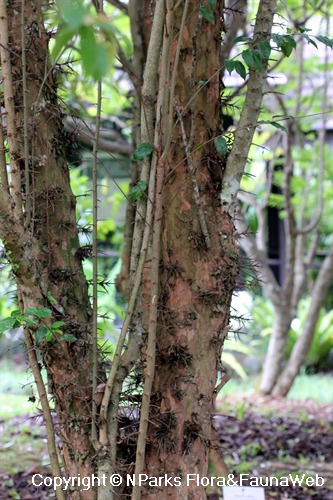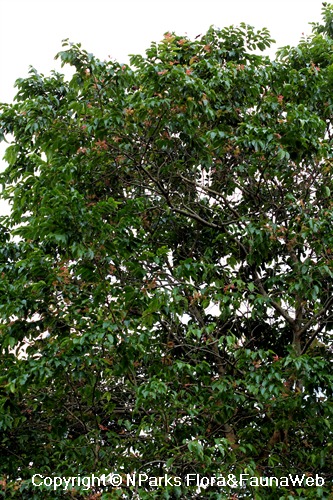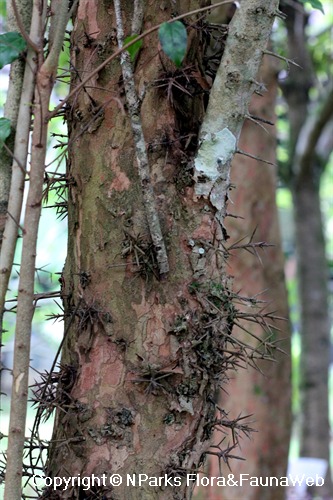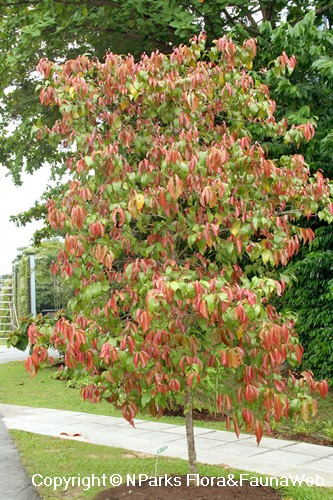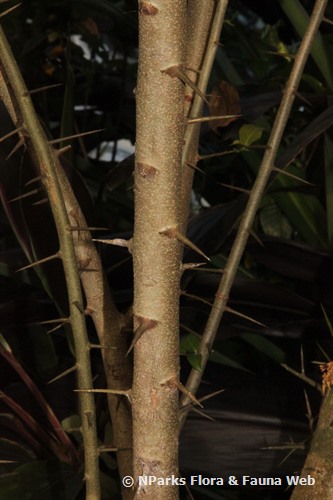.jpg)
Back
Flacourtia rukam Zoll. & Moritzi
| Family Name: | Salicaceae |
| Synonyms: | Flacourtia edulis Griff., Flacourtia euphlebia Merr., Flacourtia megaphylla Ridl., Flacourtia peninsula Elm., Flacourtia sulcata Elm. |
| Common Name: | Indian Prune, Rukam Manis, 大叶刺篱木 |
Flacourtia rukam also known as Indian Prune is a medium-sized tree native to Singapore. Its young flushes of glossy and rose-red to brown coloured leaves are eye-catching in the landscape. The round-ish fruit is dark red and edible when ripe. This cherry-like fruit is acidic and astringent but when bruised, the flesh taste sweet and is commonly used to make jams and pies.
Name
Classifications and Characteristics
| Plant Division | Angiosperms (Flowering Seed Plants) (Dicotyledon) |
|---|---|
| Plant Growth Form | Tree (Medium (16m-30m)) |
| Lifespan (in Singapore) | Perennial |
| Mode of Nutrition | Autotrophic |
| Plant Shape | Irregular |
| Maximum Height | 20 m |
Biogeography
| Native Distribution | Hainan, Indochina, southern Thailand through Malaysia, Singapore, the Philippines, Indonesia, and Brunei to Papua New Guinea |
|---|---|
| Native Habitat | Terrestrial (Primary Rainforest, Secondary Rainforest, Freshwater Swamp Forest, Riverine) |
| Preferred Climate Zone | Tropical, Sub-Tropical / Monsoonal |
| Local Conservation Status | Native to Singapore (Vulnerable (VU)) |
Description and Ethnobotany
| Growth Form | It is a tree up to 20 m tall. |
|---|---|
| Foliage | Its alternate, stalked leaves have leathery to almost leathery leaf blades that are red to brown when young, egg-shaped-oblong, oval to oblong-lance-shaped, 6.5–18 by 3–9 cm, and with toothed margins. |
| Flowers | Its flowering clusters are finely covered with hair and found at the leaf axils. They bear few greenish-yellow flowers. |
| Fruit | Its stalked fruits are globose to depressed globose, or drop-shaped, turning pink or dark red when ripe, 2–2.5 cm wide, and topped by a ring of styles. |
| Habitat | It grows in evergreen primary and secondary forests, often along rivers, up to 2,100 m altitude. |
| Associated Fauna | Its flowers are insect-pollinated. It is the butterfly host plant and caterpillar food plant for the Leopard butterfly (Phalanta phalantha phalantha), Rustic butterfly (Cupha erymanthis) and Vagrant butterfly (Vagrans sinha sinha). |
| Etymology | Latin flacourtia, commemorating Etienne de Flacourt (1607–1660), the director of the French East India company; Javanese rukam, the vernacular name of this species |
| Ethnobotanical Uses | Edible Plant Parts : Edible Fruits Food (Fruit or Vegetable): The plant is cultivated for its edible fruits for jam. Medicinal: The juice of the fruits used for dysentery, dysmenorrhea, and diarrhea. The juice of the leaves is applied to inflamed eyelids. Timber & Products: The wood is hard and used to make pestles or shafts in the Philippines. |
Landscaping Features
| Landscaping | It is suitable for parks. |
|---|---|
| Desirable Plant Features | Ornamental Foliage, Ornamental Fruits |
| Landscape Uses | Parks & Gardens, Riverine |
| Usage Hazard - Cons | Spines/Thorns - Stem/Branch |
Fauna, Pollination and Dispersal
| Fauna Pollination Dispersal Associated Fauna | Butterfly Host Plant (Leaves) |
|---|---|
| Pollination Method(s) | Biotic (Fauna) |
| Seed or Spore Dispersal | Biotic (Fauna) |
Plant Care and Propagation
| Light Preference | Full Sun |
|---|---|
| Water Preference | Moderate Water |
| Plant Growth Rate | Moderate |
| Rootzone Tolerance | Moist Soils, Well-Drained Soils, Fertile Loamy Soils |
| Pest(s) | Chewing Insects |
| Propagation Method | Seed, Stem Cutting |
Foliar
| Foliage Retention | Evergreen |
|---|---|
| Mature Foliage Colour(s) | Green |
| Mature Foliage Texture(s) | Leathery |
| Prominent Young Flush Colour(s) | Brown, Red |
| Foliar Type | Simple / Unifoliate |
| Foliar Arrangement Along Stem | Alternate |
| Foliar Attachment to Stem | Petiolate |
| Foliar Shape(s) | Non-Palm Foliage (Oval, Oblong, Elliptical, Lanceolate) |
| Foliar Venation | Pinnate / Net |
| Foliar Margin | Serrate / Toothed |
| Leaf Area Index (LAI) for Green Plot Ratio | 3.0 (Tree - Intermediate Canopy) |
Floral (Angiosperm)
| Flower & Plant Sexuality | Bisexual Flowers |
| Flower Colour(s) | Green - Light Green |
|---|---|
| Flower Grouping | Cluster / Inflorescence |
| Flower Location | Axillary |
Fruit, Seed and Spore
| Mature Fruit Colour(s) | Pink, Red |
|---|---|
| Fruit Classification | Simple Fruit |
| Fruit Type | Fleshy Fruit , Non-Accessory Fruit |
Image Repository
Others
| Master ID | 1628 |
|---|---|
| Species ID | 5182 |
| Flora Disclaimer | The information in this website has been compiled from reliable sources, such as reference works on medicinal plants. It is not a substitute for medical advice or treatment and NParks does not purport to provide any medical advice. Readers should always consult his/her physician before using or consuming a plant for medicinal purposes. |

.jpg)
.jpg)
.jpg)
